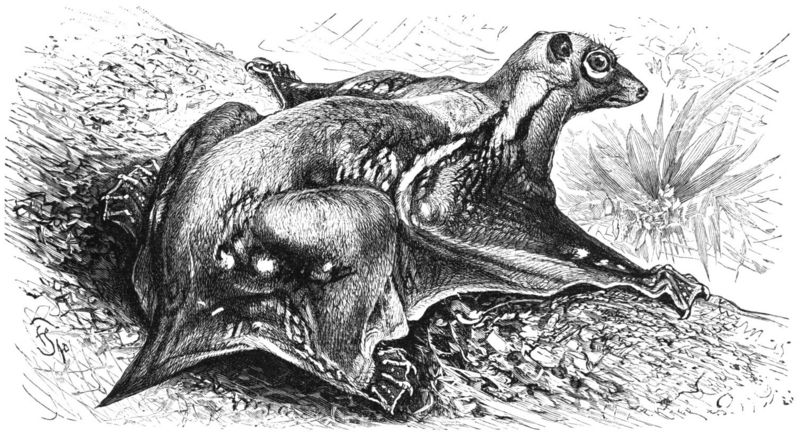|
| Query: Dermotherium chimaera | Result: 1st of 1 | |
Colugo, Flying Lemur (Order: Dermoptera, Family: Cynocephalidae) - Wiki
| Subject: | Colugo, Flying Lemur (Order: Dermoptera, Family: Cynocephalidae) - Wiki
| |

| Resolution: 1512x822
File Size: 373427 Bytes
Upload Date: 2007:11:02 17:18:43
|
Colugo
From Wikipedia, the free encyclopedia
[Photo] Philippine Flying Lemur (Cynocephalus volans) drawing. Kaguang, Galeopithecus volans L. Originator: Friedrich Specht. Source: Brehms Tierleben, Small Edition 1927.
Colugos are arboreal gliding mammals found in South-east Asia. There are just two extant species, each in its own genus, which make up the entire family Cynocephalidae and order Dermoptera. Though they are the most capable of all mammal gliders, they cannot actually fly. They are also known as cobegos or flying lemurs (misleadingly, since they are not lemurs and cannot fly).
Colugos are fairly large for a tree-dwelling mammal: at about 35 to 40 cm (14 to 16 in) in length and 1 or 2 kilograms (2 or 4 pounds) in weight, they are comparable to a medium-sized possum or a very large squirrel. They have moderately long, slender limbs of equal length front and rear, a medium-length tail, and a relatively light build. The head is small, with large, front-focused eyes for excellent binocular vision, and small, rounded ears. When born, the Colugo weighs only about 35g (1.2oz) and do not reach adult size for 2???3 years.
Their most distinctive feature, however, is the membrane of skin that extends between their limbs and gives them the ability to glide long distances between trees. Of all the gliding mammals, the colugos have the most extensive adaptation to flight. Their gliding membrane, or patagium, is as large as is geometrically possible: it runs from the shoulder blades to the fore-paw, from the tip of the rear-most finger to the tip of the toes, and from the hind legs to the tip of the tail; unlike in other known gliding mammals even the spaces between the fingers and toes are webbed to increase the total surface area, as in the wings of bats. As a result, colugos were traditionally considered being close to the ancestors of bats, but are now usually seen as the closest living relatives to primates.
They are surprisingly clumsy climbers. Lacking opposable thumbs and not being especially strong, they proceed upwards in a series of slow hops, gripping onto the bark of trees with their small, sharp claws. They are as comfortable hanging underneath a branch as sitting on top of it. In the air, however, they are very capable, and can glide as far as 70 metres (230 feet) from one tree to another with minimal loss of height.
Colugos are shy, nocturnal, and restricted to the tropical rainforests of Southeast Asia. In consequence, remarkably little is known about their habits. They are certainly herbivores, and are thought to eat mostly leaves, shoots, flowers and sap, and probably fruit as well. They have well-developed stomachs capable of extracting nutriment from leaves.
ORDER DERMOPTERA
Family Cynocephalidae
Cynocephalus
Philippine Flying Lemur, Cynocephalus volans
Galeopterus
Sunda Flying Lemur, Galeopterus variegatus
†Dermotherium
†Dermotherium major
†Dermotherium chimaera
Both species are threatened by habitat destruction, and the Philippine Flying Lemur is classified by the IUCN as vulnerable. In addition to the ongoing clearing of its rainforest habitat, it is hunted for its meat and fur. It is also hunted by the gravely endangered Philippine Eagle: some studies suggest that colugos account for 90% of the eagle's diet. It is not known how the diurnal eagles catch so many of the nocturnal colugos, which are thought to spend the greater part of the day curled up in tree hollows or hanging inconspicuously underneath a branch.
The Mixodectidae appear to be fossil Dermoptera. However although other Paleogene mammals have been interpreted as related to Dermopterans, the evidence for this is uncertain and many of them are no longer interpreted as being gliding mammals. At present, the fossil record of definitive dermopterans is limited to two species of the Eocene and Oligocene cynocephalid genus Dermotherium.
Although they are placental mammals, colugos are almost marsupial-like in their breeding habits. The young are born after just 60 days of gestation in a tiny and undeveloped form, and spend their first six months or so of life clinging to the mother's belly. To protect them and transport them she curls her tail up to fold the gliding membrane into a warm, secure quasi-pouch. Breeding is fairly slow as the young do not reach full size until they are two or three years old.
Recent molecular phylogenetic studies have demonstrated that colugos belong to the clade Euarchonta along with the treeshrews (order Scandentia) and the primates. In this taxonomy, the Euarchonta are sister to the Glires (lagomorphs and rodents), and the two groups are combined into the clade Euarchontoglires.
Synonyms
The names Colugidae, Galeopithecidae and Galeopteridae are synonyms for Cynocephalidae. Colugo, Dermopterus, Galeolemur, Galeopithecus, Galeopus, and Pleuropterus are synonyms for Cynocephalus.
http://en.wikipedia.org/wiki/Colugo
| The text in this page is based on the copyrighted Wikipedia article shown in above URL. It is used under the GNU Free Documentation License. You may redistribute it, verbatim or modified, providing that you comply with the terms of the GFDL. |
|
Comments |
|---|
| | Guest |
|
Scientific Name: Cynocephalus volans (Linnaeus, 1758)
Common Names: Philippine Flying Lemur, Flying Lemur
Synonyms: Cynocephalus philippinensis Waterhouse, 1838 |
^o^
Animal Pictures Archive for smart phones
^o^
|
|
|